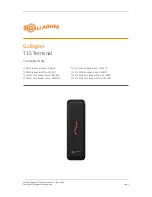
Operating Instructions
Chapter
4
CLV 480 Bar Code Scanner
8 010 080/O824/10-02-2005
©
SICK AG · Division Auto Ident · Germany · All rights reserved
4-5
Installation
Angular alignment of the CLV
The alignment of the CLV is optimum when the scan line travels over the bar code lines
almost at a right angle (90
°
) (
). All possible reading angles that can occur between
the scan line and the bar code must be taken into consideration (
Note
If reading from the front, mount the CLV above the conveyor belt in such a way against the
conveying direction that the scan line hits the object under a skew of approx. 10
°
.
Avoiding surface reflection
If the light from the scan line strikes the surface of the bar code vertically, interference may
be caused by reflections when the returned light is received. To avoid surface reflection, the
CLV must be mounted in such a way that the emitted light is tilted slightly with respect to the
vertical axis (
In the case of the line scanner with oscillating mirror, the laser beam is emitted at an angle
of 105
°
with respect to the housing as it passes through the neutral position (CW = 50)
while oscillating. The device can only be flush-mounted with the conveyor belt with limited
deflection ranges. Otherwise, the device must also be mounted at an angle of 15
°
to ensure
that the deflection ranges are symmetric.
Fig. 4-6:
Line scanner: Reading angle between the scan line and the bar code
CLV
α:
Azimuth angle (tilt)
β:
Angle of inclination (pitch)
γ:
Angle of rotation (skew)
Reading
range
Reading
distance
Angle
Limit value
Tilt
α
(azimuth)
max. 45
°
(limitations see reading diagrams)
Pitch
β
max. 45
°
Skew
γ
max. 45
°
Table 4-1: Permissible reading angles between the scan line and bar code
Fig. 4-7:
Avoiding surface reflections: Angle between the emitted light and the bar code (tilted
away from the vertical axis)
15
°
Line scanner
Line scanner with oscillating mirror
(Top view)
(Side view)
15
°
105
°
















































